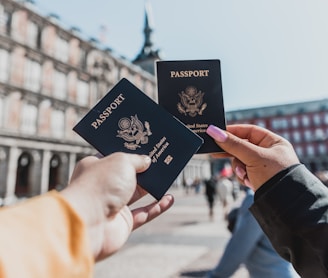Understanding Visa Types For The U.S.
2/20/20242 min read


Navigating the long list of U.S. visa applications can be scary for many, with a large amount of visa types and varying appointment wait times complicating the journey. This guide aims to shed light on these aspects, helping you understand the right visa for your needs and what to expect throughout the application process.
Understanding U.S. Visa Types
Nonimmigrant Visas are designed for individuals intending to visit the U.S. temporarily. They cater to various purposes, including tourism (B-2), business (B-1), study (F-1, M-1), and temporary work (H, L, O, P visas). Each category has specific criteria and documentation requirements.
Immigrant Visas are for those looking to relocate permanently to the U.S. They are often categorized by family-based visas, where U.S. citizens or permanent residents sponsor a relative, and employment-based visas, which depend on a U.S. employer’s sponsorship.
Special Categories and Programs include the Visa Waiver Program (VWP), allowing citizens of certain countries to visit the U.S. for tourism or business for stays of 90 days or less without obtaining a visa.
Determining the Right Visa for You
Choosing the correct visa type is crucial for a successful application. The U.S. Department of State provides a Visa Wizard tool on its website, which can guide you in selecting the appropriate visa based on your travel purpose. For more complex situations, consulting with immigration lawyers or advisors can provide tailored guidance.
The Visa Application Process
The process generally starts with completing the DS-160 form online for nonimmigrant visas or the DS-260 form for immigrant visas. After paying the required visa fee, the next step is scheduling an interview at the nearest U.S. embassy or consulate. The documentation required varies by visa type but typically includes proof of your travel purpose, financial stability, and ties to your home country.
Understanding Visa Appointment Wait Times
Appointment wait times can vary significantly based on the visa type, location of the U.S. embassy or consulate, and time of year. These wait times are influenced by various factors, including application volume and staffing levels at consulates. Applicants can check current wait times on the U.S. Department of State’s website, which is updated regularly.
Tips for a Successful Visa Interview
Preparation is key to navigating the visa interview successfully. Gather all necessary documents in advance and practice answering potential questions about your travel purpose, financial means, and ties to your home country. Be honest and concise in your responses during the interview.
Understanding the different U.S. visa types and preparing for the appointment and wait times can streamline your application process. While it may seem overwhelming, thorough preparation and early application can enhance your chances of a successful visa application. Remember, patience and meticulous attention to detail are your best allies in this journey.
For more detailed information, visiting the official U.S. Department of State website and the specific U.S. Embassy or Consulate website where you plan to apply is highly recommended.
To navigate the U.S. visa application process more effectively, here are some resources and helpful information
DS-160 Online Nonimmigrant Visa Application: For nonimmigrant visa applicants, this is the form you’ll need to complete. DS-160 Application
U.S. Department of State — Bureau of Consular Affairs: The official source for all visa-related information, including types of visas, application steps, and fees. travel.state.gov
Visa Interview Preparation: Boundless provides a detailed guide on preparing for your visa interview, including sample questions. Boundless — Visa Interview Guide